Content for TS 38.305 Word version: 18.3.0
1…
4…
5…
6…
6.5…
6.7…
7…
7.3A…
7.4…
7.6…
7.11…
7.12…
8…
8.1.2.1a…
8.1.3…
8.2…
8.3…
8.4…
8.5…
8.6…
8.7…
8.8…
8.9…
8.10…
8.11…
8.12…
8.13…
8.14…
8.15…
A…
8.12 DL-TDOA positioning
8.12.1 General
8.12.2 Information to be transferred between NG-RAN/5GC Elements
8.12.2.0 General
8.12.2.1 Information that may be transferred from the LMF to UE
8.12.2.1.0 General
8.12.2.1.1 Mapping of integrity parameters
8.12.2.2 Information that may be transferred from the UE to LMF
8.12.2.3 Information that may be transferred from the gNB to LMF
8.12.3 DL-TDOA Positioning Procedures
8.12.3.0 General
8.12.3.1 Procedures between LMF and UE
8.12.3.1.1 Capability Transfer Procedure
8.12.3.1.2 Assistance Data Transfer Procedure
8.12.3.1.2.0 General
8.12.3.1.2.1 LMF initiated Assistance Data Delivery
8.12.3.1.2.1a LMF initiated Periodic Assistance Data Delivery
8.12.3.1.2.2 UE initiated Assistance Data Transfer
8.12.3.1.2.2a UE initiated Periodic Assistance Data Transfer
8.12.3.1.3 Location Information Transfer Procedure
8.12.3.1.3.0 General
8.12.3.1.3.1 LMF-initiated Location Information Transfer Procedure
8.12.3.1.3.2 UE-initiated Location Information Delivery procedure
8.12.3.2 Procedures between LMF and gNB
8.12.3.2.1 Assistance Data Delivery procedure
8.12.3.2.1.0 General
8.12.3.2.1.1 LMF-initiated assistance data delivery to the LMF
...
...
8.12 DL-TDOA positioning |R16| p. 143
8.12.1 General p. 143
In the DL-TDOA positioning method, the UE position is estimated based on DL RSTD (and optionally DL-PRS-RSRP and/or DL-PRS-RSRPP and/or DL-RSCPD) measurements taken at the UE of downlink radio signals from multiple NR TRPs, along with knowledge of the geographical coordinates of the TRPs and their relative downlink timing.
The UE while connected to a gNB may require measurement gaps to perform the DL-TDOA measurements from NR TRPs. The UE may request measurement gaps from a gNB using the procedure described in clause 7.4.1.1. The UE may also request to activate pre-configured measurement gaps as described in clause 7.7.2.
The specific positioning techniques used to estimate the UE's location from this information are beyond the scope of this specification.
8.12.2 Information to be transferred between NG-RAN/5GC Elements p. 143
8.12.2.0 General |R18| p. 143
This clause defines the information that may be transferred between LMF and UE/gNB.
8.12.2.1 Information that may be transferred from the LMF to UE p. 143
8.12.2.1.0 General |R18| p. 143
The information that may be transferred from the LMF to the UE are listed in Table 8.12.2.1.0-1.
| Information | UE-assisted | UE-based |
|---|---|---|
| Physical cell IDs (PCIs), global cell IDs (GCIs), ARFCN, and PRS IDs of candidate NR TRPs for measurement | Yes | Yes |
| Timing relative to the serving (reference) TRP of candidate NR TRPs | Yes | Yes |
| DL-PRS configuration of candidate NR TRPs | Yes | Yes |
| Indication of which DL-PRS Resource Sets across DL-PRS positioning frequency layers are linked for DL-PRS bandwidth aggregation | Yes | Yes |
| SSB information of the TRPs (the time/frequency occupancy of SSBs) | Yes | Yes |
| Spatial direction information (e.g. azimuth, elevation etc.) of the DL-PRS Resources of the TRPs served by the gNB | No | Yes |
| Geographical coordinates of the TRPs served by the gNB (include a transmission reference location for each DL-PRS Resource ID, reference location for the transmitting antenna of the reference TRP, relative locations for transmitting antennas of other TRPs) | No | Yes |
| Fine Timing relative to the serving (reference) TRP of candidate NR TRPs | No | Yes |
| PRS-only TP indication | Yes | Yes |
| The association information of DL-PRS resources with TRP Tx TEG ID | No | Yes |
| LOS/NLOS indicators | No | Yes |
| On-Demand DL-PRS-Configurations, possibly together with information on which configurations are available for DL-PRS bandwidth aggregation | Yes | Yes |
| Validity Area of the Assistance Data | Yes | Yes |
| PRU measurements together with the location information of the PRU | No | Yes |
| Data facilitating the integrity results determination of the calculated location | No | Yes |
8.12.2.1.1 Mapping of integrity parameters |R18| p. 143
Table 8.12.2.1.1-1 shows the mapping between the integrity fields and the assistance data according to the Integrity Principle of Operation (Clause 7.13.2). The corresponding field descriptions for each of the field names listed in Table 8.12.2.1.1-1 are specified in TS 37.355.
| Error | NR Assistance Data | Integrity Fields | ||||
|---|---|---|---|---|---|---|
| Integrity Alerts | Integrity Bounds (Mean) | Integrity Bounds (StdDev) | Residual Risks | Integrity Correlation Times | ||
| TRP location | NR-TRP-LocationInfo | TRP DNU | Mean TRP/ARP location error | Standard deviation TRP/ARP location error | Probability of Onset of TRP fault Mean TRP fault duration | TRP/ARP location error correlation time |
| Inter-TRP synchronization | NR-RTD-Info | RTD DNU | Mean RTD error | Standard deviation RTD error | RTD error correlation time | |
8.12.2.2 Information that may be transferred from the UE to LMF p. 144
8.12.2.2.0 General |R18| p. 144
The information that may be signalled from UE to the LMF is listed in Table 8.12.2.2.0-1. The individual UE measurements are defined in TS 38.215.
| Information | UE-assisted | UE-based |
|---|---|---|
| Latitude/Longitude/Altitude, together with uncertainty shape | No | Yes |
| PCI, GCI, ARFCN, PRS resource ID, PRS resource set ID and PRS ID for each measurement | Yes | No |
| DL RSTD measurement | Yes | No |
| DL-PRS-RSRP measurement | Yes | No |
| DL-RSCPD measurement, NOTE 1, NOTE 2 | Yes | No |
| Time stamp of the measurements | Yes | No |
| Time stamp of location estimate | No | Yes |
| Quality for each measurement | Yes | No |
| UE Rx TEG IDs for DL RSTD measurements | Yes | No |
| DL-PRS-RSRPP measurement | Yes | No |
| LOS/NLOS information for UE measurements | Yes | No |
| Indication that DL-PRS bandwidth aggregation has been used for DL RSTD measurement | Yes | No |
| Indication that the reported measurements are based on receiving single or multiple hops of DL-PRS | Yes | No |
| Protection Level, optionally together with achievable Target Integrity Risk | No | Yes |
|
NOTE 1:
The DL-RSCPD measurement may be reported along with the DL RSTD measurement.
NOTE 2:
The DL-RSCPD is measured from a single DL PRS positioning frequency layer.
|
||
8.12.2.3 Information that may be transferred from the gNB to LMF p. 144
8.12.2.3.0 General |R18| p. 144
The assistance data that may be transferred from gNB to the LMF is listed in Table 8.12.2.3.0-1.
| Information |
|---|
| PCI, GCI, ARFCN, and TRP IDs of the TRPs served by the gNB |
| Timing information of TRPs served by the gNB |
| DL-PRS configuration of the TRPs served by the gNB |
| Indication of which DL-PRS Resource Sets across DL-PRS positioning frequency layers are linked for DL-PRS bandwidth aggregation |
| SSB information of the TRPs (the time/frequency occupancy of SSBs) |
| Spatial direction information of the DL-PRS Resources of the TRPs served by the gNB |
| Geographical coordinates information of the DL-PRS Resources of the TRPs served by the gNB |
| TRP type |
| On-demand DL-PRS information, possibly together with information on which configurations are available for DL-PRS bandwidth aggregation |
| TRP Tx TEG association information |
| Mobile TRP Location Information |
| Mobile IAB-MT UE ID (NOTE 1) |
|
NOTE 1:
If TRP Type is Mobile TRP.
|
8.12.3 DL-TDOA Positioning Procedures p. 145
8.12.3.0 General |R18| p. 145
The procedures described in this clause support UE-assisted and UE-based DL-TDOA.
8.12.3.1 Procedures between LMF and UE p. 145
8.12.3.1.1 Capability Transfer Procedure p. 145
The Capability Transfer procedure for DL-TDOA positioning is described in clause 7.1.2.1.
8.12.3.1.2 Assistance Data Transfer Procedure p. 145
8.12.3.1.2.0 General p. 145
The purpose of this procedure is to enable the LMF to provide assistance data to the UE (e.g., as part of a positioning procedure) and the UE to request assistance data from the LMF (e.g., as part of a positioning procedure). The LMF may provide the pre-configured DL-PRS assistance data (with associated validity criteria) to the UE (before or during an ongoing LPP positioning session), to be utilized for potential positioning measurements at a future time. Pre-configured DL-PRS assistance data may consist of multiple instances, where each instance is applicable to a different area within the network. One or more assistance data instances may be provided. Each instance is provided in one LPP Assistance Data messages.
If a UE receives assistance data for a TRP for which it has already stored assistance data, it overwrites the stored assistance data, whereas if a UE receives assistance data for a TRP for which it has not stored assistance data, it stores the assistance data for the TRP and maintains the already stored assistance data for other TRPs. The TRPs are uniquely identified using a combination of PRS-ID and Cell-ID. The number TRPs for which the UE can store Assistance Data is a UE capability and is indicated by the number of areas a UE can support.
8.12.3.1.2.1 LMF initiated Assistance Data Delivery p. 145
Figure 8.12.3.1.2.1-1 shows the Assistance Data Delivery operations for the DL-TDOA positioning method when the procedure is initiated by the LMF.
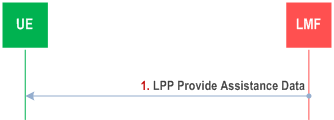
Step 1.
The LMF determines that assistance data needs to be provided to the UE (e.g., as part of a positioning procedure) and sends an LPP Provide Assistance Data message to the UE. This message may include any of the DL-TDOA positioning assistance data defined in Table 8.12.2.1.0-1.
8.12.3.1.2.1a LMF initiated Periodic Assistance Data Delivery p. 146
The Periodic Assistance Data Delivery procedure allows the server to provide unsolicited periodic assistance data to the target and is shown in Figure 8.12.3.1.2.1a-1.
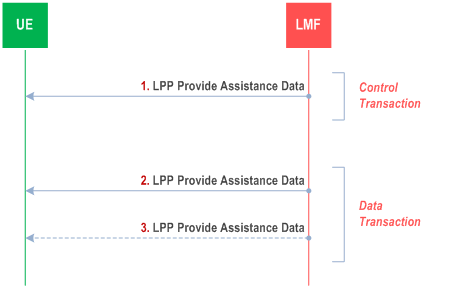
Step 1.
The LMF determines that assistance data needs to be provided to the UE and sends an LPP Provide Assistance Data message to the UE. This message includes information to identify the type of periodic assistance data and a duration for ending the assistance data delivery. The message indicates the end of the control transaction.
Step 2.
When the first periodic message is available, the LMF sends an unsolicited LPP Provide Assistance Data message to the UE containing the periodic assistance data announced in step (1).
Step 3.
The LMF may continue to send further LPP Provide Assistance Data messages to the target containing the periodic assistance data announced in step (1) when each additional periodicity condition occurs. When the duration for ending the periodic assistance data transfer occurs, the last LPP Provide Assistance Data message transferred indicates the end of transaction. Additionally, the session can be ended on request by the UE or by the LMF with the help of an Abort message.
8.12.3.1.2.2 UE initiated Assistance Data Transfer p. 147
Figure 8.12.3.1.2.2-1 shows the Assistance Data Transfer operations for the DL-TDOA positioning method when the procedure is initiated by the UE.
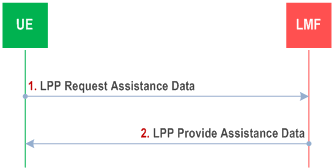
Step 1.
The UE determines that certain DL-TDOA positioning assistance data are desired (e.g., as part of a positioning procedure when the LMF provided assistance data are not sufficient for the UE to fulfil the request) and sends an LPP Request Assistance Data message to the LMF. This request includes an indication of which specific DL-TDOA assistance data are requested. Additional information concerning the UE's approximate location and serving and neighbour cells may also be provided in the Request Assistance Data message and/or in an accompanying Provide Location Information message to help the LMF provide appropriate assistance data. This additional data may include the UE's last known location if available, the cell IDs of the UE serving NG-RAN node and possibly neighbour NG-RAN nodes, as well as NR E-CID measurements.
Step 2.
The LMF provides the requested assistance in an LPP Provide Assistance Data message, if available at the LMF. If any of the UE requested assistance data in step (1) are not provided in step 2, the UE shall assume that the requested assistance data are not supported, or currently not available at the LMF. If none of the UE requested assistance data in step (1) can be provided by the LMF, return any information that can be provided in an LPP message of type Provide Assistance Data which includes a cause indication for the not provided assistance data.
8.12.3.1.2.2a UE initiated Periodic Assistance Data Transfer p. 147
Figure 8.12.3.1.2.2a-1 shows the Periodic Assistance Data Transfer operations when the procedure is initiated by the UE.
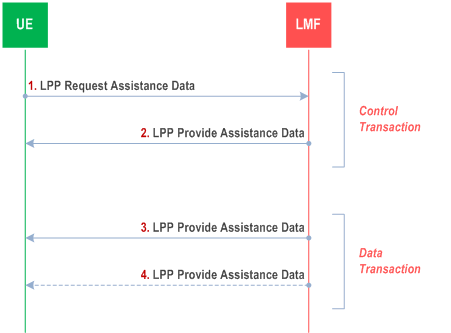
Step 1.
The UE determines that periodic assistance data are desired and sends a LPP Request Assistance Data message to the LMF. This request includes an indication of which specific assistance data are requested together with additional information such as desired periodicity for sending the assistance data and a duration for ending the periodic assistance data delivery session.
Step 2.
The LMF responds with a LPP Provide Assistance Data message to the UE. If the UE request can be supported, the message contains information which may confirm or redefine the type of assistance data or periodicity parameters requested at step (1). This response indicates the end of the control transaction.
Step 3.
When available, the LMF provides the requested assistance data in a LPP Provide Assistance Data message to the UE. If any of the requested assistance data in step (1) or redefined in step (2) are not provided the UE assumes that the requested assistance data are not supported, or currently not available at the LMF.
Step 4.
The LMF may transmit one or more additional LPP Provide Assistance Data messages to the UE containing further periodic assistance data confirmed or redefined in step (2). When the duration for ending the periodic assistance data transfer occur, the last LPP Provide Assistance Data message transferred indicates the end of the transaction. Additionally, the periodic assistance data delivery session can be ended on request by the UE or by the LMF with the help of an Abort message.
8.12.3.1.3 Location Information Transfer Procedure p. 148
8.12.3.1.3.0 General p. 148
The purpose of this procedure is to enable the LMF to request location estimate from the UE, or to enable the UE to provide location measurements to the LMF for position calculation.
8.12.3.1.3.1 LMF-initiated Location Information Transfer Procedure p. 148
Figure 8.12.3.1.3.1-1 shows the Location Information Transfer operations for the DL-TDOA positioning method when the procedure is initiated by the LMF.
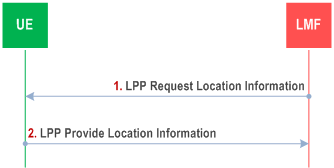
Step 1.
The LMF sends an LPP Request Location Information message to the UE. This request includes positioning instructions such as the positioning mode (UE-assisted, UE-based, UE-based preferred but UE-assisted allowed, UE-assisted preferred, but UE-based allowed), indication of DL-TDOA measurements requested if any, including any needed measurement configuration information, required response time, and possibly integrity requirements.
The LPP Request Location Information message may include one or more time windows during which the target device is requested to perform the DL-TDOA measurements on indicated DL-PRS Resource Sets.
The LPP Request Location Information message may include a request to perform joint DL-RSTD measurements across two or three DL-PRS positioning frequency layers.
The LPP Request Location Information message may include a request to perform the DL-TDOA measurements using receiver frequency hopping for a DL PRS resource within a configured measurement gap.
Step 2.
The UE obtains DL-TDOA measurements as requested in step 1 and possibly calculates its own location. The UE may also determine the integrity results of the calculated location. The UE then sends an LPP Provide Location Information message to the LMF, before the Response Time provided in step (1) elapsed, and includes the obtained DL-TDOA measurements or calculated location. If the UE is unable to perform the requested measurements, or the Response Time elapsed before any of the requested measurements were obtained, the UE returns any information that can be provided in an LPP message of type Provide Location Information which includes a cause indication for the not provided location information.
8.12.3.1.3.2 UE-initiated Location Information Delivery procedure p. 149
Figure 8.12.3.1.3.2-1 shows the Location Information Delivery procedure operations for the DL-TDOA positioning method when the procedure is initiated by the UE.
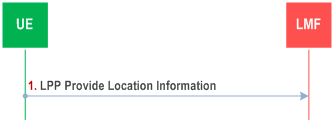
Step 1.
The UE sends an LPP Provide Location Information message to the LMF. The Provide Location Information message may include any UE DL-TDOA measurements and, optionally, the DL-PRS-RSRP measurements already available at the UE.
8.12.3.2 Procedures between LMF and gNB p. 150
8.12.3.2.1 Assistance Data Delivery procedure p. 150
8.12.3.2.1.0 General p. 150
The purpose of this procedure is to enable the gNB to provide assistance data to the LMF, for subsequent delivery to the UE using the procedures of clause 8.12.3.1.2 or for use in the calculation of positioning estimates at the LMF.
8.12.3.2.1.1 LMF-initiated assistance data delivery to the LMF p. 150
Figure 8.12.3.2.1.1-1 shows the TRP Information Exchange operation from the gNB to the LMF for the DL-TDOA positioning method.
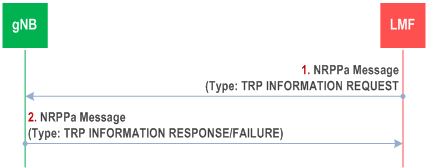
Step 1.
The LMF determines that certain TRP configuration information is desired (e.g., as part of a periodic update or as triggered by OAM) and sends an NRPPa TRP INFORMATION REQUEST message to the gNB. This request includes an indication of which specific TRP configuration information is requested.
Step 2.
The gNB provides the requested TRP information in an NRPPa TRP INFORMATION RESPONSE message, if available at the gNB. If the gNB is not able to provide any information, it returns an TRP INFORMATION FAILURE message indicating the cause of the failure.